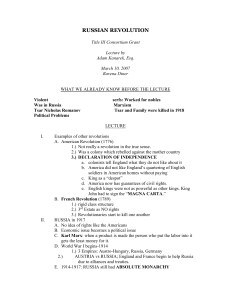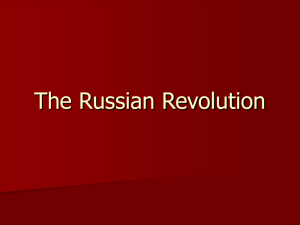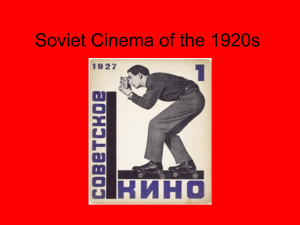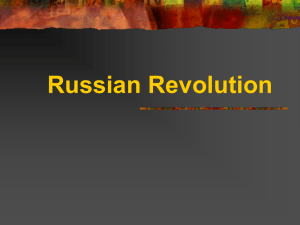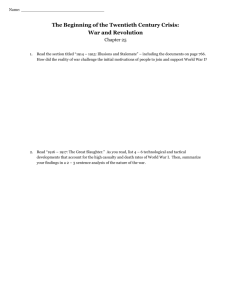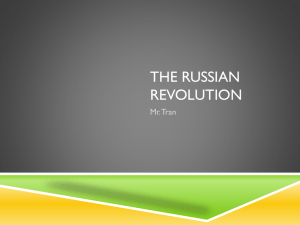8.2 The Russian Revolution Br MrGilson
advertisement
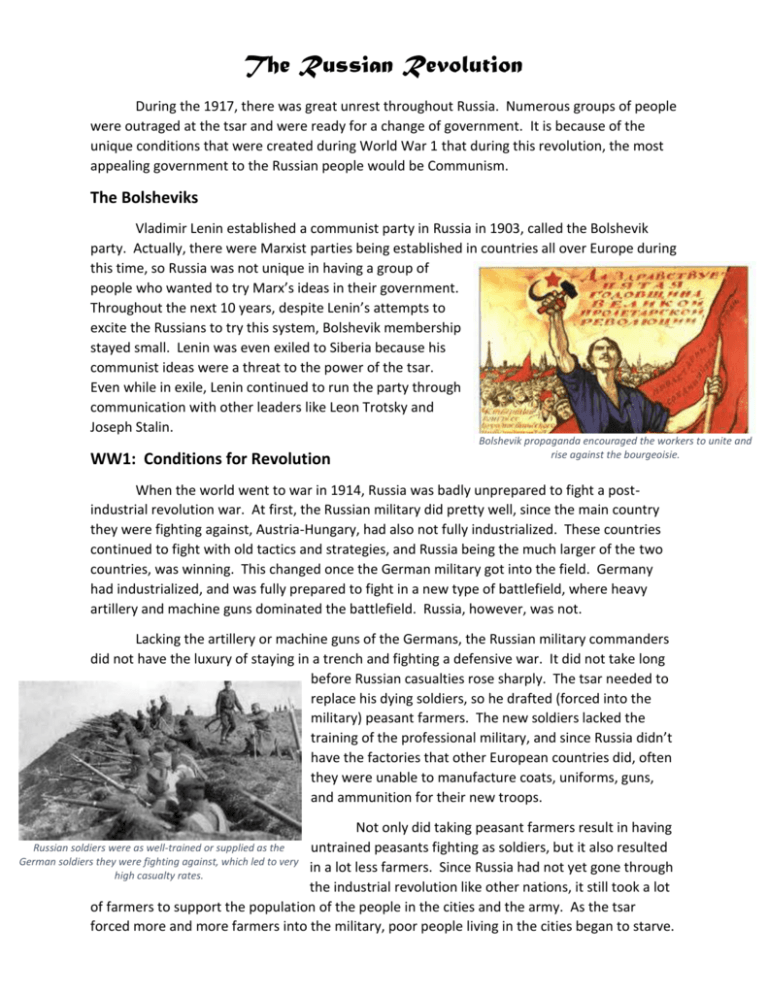
The Russian Revolution During the 1917, there was great unrest throughout Russia. Numerous groups of people were outraged at the tsar and were ready for a change of government. It is because of the unique conditions that were created during World War 1 that during this revolution, the most appealing government to the Russian people would be Communism. The Bolsheviks Vladimir Lenin established a communist party in Russia in 1903, called the Bolshevik party. Actually, there were Marxist parties being established in countries all over Europe during this time, so Russia was not unique in having a group of people who wanted to try Marx’s ideas in their government. Throughout the next 10 years, despite Lenin’s attempts to excite the Russians to try this system, Bolshevik membership stayed small. Lenin was even exiled to Siberia because his communist ideas were a threat to the power of the tsar. Even while in exile, Lenin continued to run the party through communication with other leaders like Leon Trotsky and Joseph Stalin. WW1: Conditions for Revolution Bolshevik propaganda encouraged the workers to unite and rise against the bourgeoisie. When the world went to war in 1914, Russia was badly unprepared to fight a postindustrial revolution war. At first, the Russian military did pretty well, since the main country they were fighting against, Austria-Hungary, had also not fully industrialized. These countries continued to fight with old tactics and strategies, and Russia being the much larger of the two countries, was winning. This changed once the German military got into the field. Germany had industrialized, and was fully prepared to fight in a new type of battlefield, where heavy artillery and machine guns dominated the battlefield. Russia, however, was not. Lacking the artillery or machine guns of the Germans, the Russian military commanders did not have the luxury of staying in a trench and fighting a defensive war. It did not take long before Russian casualties rose sharply. The tsar needed to replace his dying soldiers, so he drafted (forced into the military) peasant farmers. The new soldiers lacked the training of the professional military, and since Russia didn’t have the factories that other European countries did, often they were unable to manufacture coats, uniforms, guns, and ammunition for their new troops. Not only did taking peasant farmers result in having Russian soldiers were as well-trained or supplied as the untrained peasants fighting as soldiers, but it also resulted German soldiers they were fighting against, which led to very in a lot less farmers. Since Russia had not yet gone through high casualty rates. the industrial revolution like other nations, it still took a lot of farmers to support the population of the people in the cities and the army. As the tsar forced more and more farmers into the military, poor people living in the cities began to starve. Bad management and lacking an extensive railway network, the tsar had a hard time keeping his troops supplied with food as well, and often times he would try to send food to the front lines only to have it spoil before it would get to where it was needed. The workers in the factories were also starving, and being forced to work very long and hard hours to try to make up for the fact that Russia was not able to support its troops. They were underpaid, overworked, and accidents were frequent. Often times, the wages they were paid still weren’t enough to even pay for the food their family needed. The peasant soldiers were under-trained, under-supplied, and being ordered by rich officers to charge across no-man’s land. The peasants in Russia were starving while rich families hosted dinner parties and wasted food and the factory workers were working themselves to death in a vain attempt to gain enough food to feed their starving families, while the factory owner made record profits. The solution to all of these problems seemed to be simple: force the rich to share what they had with the poor. The stage was now set for the Bolsheviks, the political group who proposed to make everyone equal by the proletariat (working-class) uniting against the bourgeoisie, to have their Revolution. The Russian Revolution (Civil War) Lenin and the Bolsheviks finally had the excuse they needed to take control of the government, and in the November Revolution, they finally gained power in Russia. One of their first actions was to make peace with Germany. The peace treaty actually gave a lot of land to Germany, but once Germany was made to sign the treaty of Versailles, the land was returned to Russia, and a few years later the Soviet Union was formed. The Revolution was a war between the Marxist Reds and the anti-communist Whites. After fighting for about 4 years, the Red Army was successful in winning the war, and established the world’s first communist society. Lenin and the Reds initially did fulfill their promise to the proletariat. Education was made available to people of all ages, and Reading Comprehension Questions health-care was offered to all 1. What four terms all refer to Russian citizens, not just to Vladimir Lenin was the founder of Communism and a hero of communists during the time of the those who could the Bolshevik Revolution. His body has been mummified and revolution? has been on display in Moscow for the last century. afford it. The land 2. Why did so many Russians starve during World War 1? that used to belong 3. Who were the 3 leaders of the Bolshevik to the tsar were taken over by the government, many party before and during the Russian turned into parks or other public places. Lenin died Revolution? two years into his rule of the newly formed Soviet Union, after which time a brief and brutal struggle Write about it. between Stalin and Trotsky would ensue to determine Create a Bolshevik propaganda poster. Your the eventual direction of the Soviet Union. target audience is uneducated peasants.





